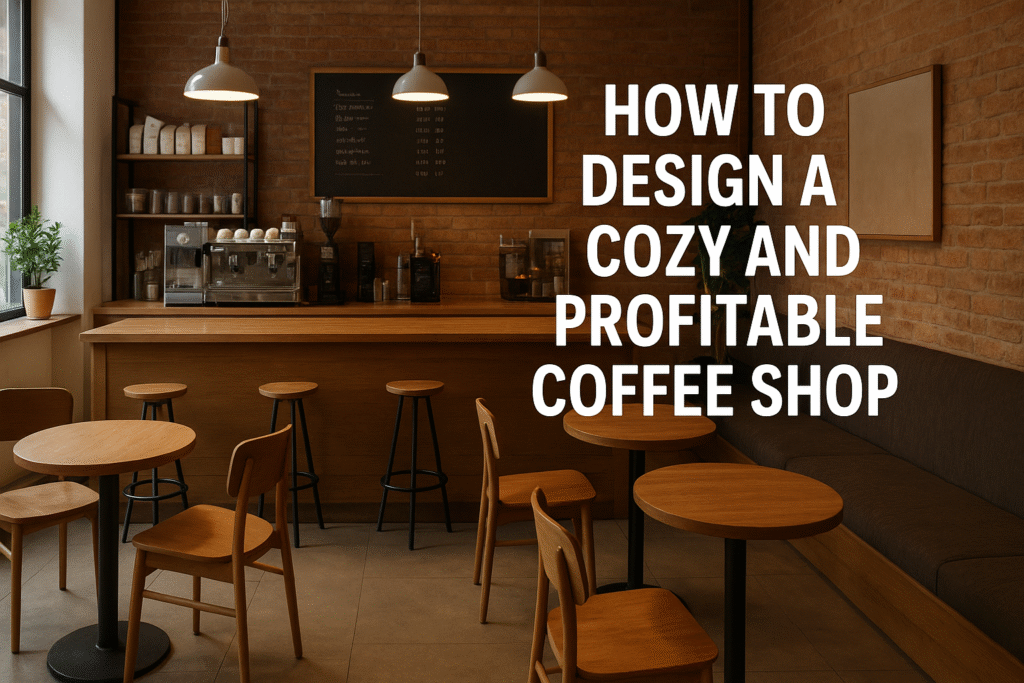Designing the perfect coffee shop layout is about more than choosing stylish furniture or trendy colors. It’s a strategic decision that directly impacts customer flow, employee productivity, and overall revenue. A well-planned layout creates a welcoming environment, encourages repeat visits, and ensures your team can work efficiently even during peak hours.
In this guide, we’ll explore practical strategies to design a cozy, functional, and profitable coffee shop space that keeps customers coming back.
Understanding Customer Flow in a Coffee Shop Layout
Before picking décor or seating arrangements, think about customer flow. A smart layout guides customers naturally from entry to ordering, pickup, and seating. Poor flow creates bottlenecks and frustration, while great flow makes the café experience seamless.
Key considerations include:
- Entry point: Is your entrance inviting and visible from the outside?
- Order station: Can customers clearly see where to order upon entering?
- Pickup area: Do you provide a designated zone for drinks to avoid crowding?
- Seating zones: Is your seating adaptable for solo visitors, couples, and groups?
When designed correctly, your coffee shop layout feels intuitive and easy for every customer.
Planning the Barista Workflow
Behind the counter, efficiency drives profitability. A poorly organized bar can lead to slower service and staff frustration. The ideal barista workflow ensures everything is within reach: the espresso machine, grinder, milk station, cups, and cleaning supplies.
Tips for optimizing the workflow:
- Place prep areas close to machines to avoid wasted steps.
- Use shelving and vertical storage to keep tools accessible.
- Design cleaning stations to encourage hygiene and efficiency.
A functional coffee bar layout reduces staff fatigue and improves service speed, ensuring customers enjoy consistent, high-quality drinks.
Choosing Flexible Seating Options
Customers visit coffee shops for diverse reasons: to relax, work, socialize, or grab a quick drink. Your seating strategy should reflect these needs while supporting comfort and community.
Effective seating options include:
- Bar stools for solo customers and short visits
- Armchairs or couches for long, cozy stays
- Communal tables to encourage networking and a sense of community
- Two-person tables that can easily combine for groups
Always keep walkways wide, allowing smooth movement while maintaining privacy between tables.
Lighting and Ambience: Setting the Mood
Lighting plays a huge role in shaping the atmosphere of your coffee shop layout. The goal is to make the space warm, inviting, and functional for different activities.
Use a mix of:
- Natural light from windows or skylights
- Warm overhead lights to create a cozy environment
- Task lighting behind the bar for staff efficiency
- Accent lighting to highlight décor, shelves, or art
Avoid harsh fluorescent lights, as they can make your café feel cold and unwelcoming. Instead, opt for warm, soft illumination that matches your brand identity.
The Importance of Acoustics in Coffee Shops
Sound is often overlooked in coffee shop design, but it significantly influences customer comfort. Too much noise drives people away, while complete silence feels unnatural.
To balance acoustics, consider:
- Soft background music that aligns with your brand personality
- Sound-absorbing décor like rugs, cushions, or wall panels
- Thoughtful speaker placement to avoid uneven sound distribution
A well-designed sound environment makes customers feel relaxed and encourages them to stay longer.
Small Details That Make a Big Difference
Sometimes it’s the little touches that make your café memorable. Paying attention to details shows customers you care about their comfort.
Enhancement ideas include:
- Charging stations or outlets near seating areas
- Coat hooks, shelves, or a small merchandise corner
- Indoor plants for freshness and a calming effect
- Easy-to-update chalkboard or digital menus visible from the entrance
- Clean, accessible bathrooms stocked with essentials
These details may seem minor, but they create a strong impression and encourage repeat visits.
Aligning Layout with Your Brand Identity
Your coffee shop layout should be a reflection of your brand. Every design choice—from furniture to wall décor—tells a story about your café.
- For a minimalist, modern café, use sleek lines, neutral tones, and simple furnishings.
- For a rustic, cozy vibe, consider reclaimed wood, vintage pieces, and warm textures.
- For a creative, artistic atmosphere, add murals, local art, and colorful accents.
Consistency across design elements ensures customers connect with your brand on a deeper level.
Designing for Long-Term Growth
When planning your coffee shop layout, think about the future. Businesses evolve, and your space should adapt with minimal disruption.
- Leave room for potential expansions, like a bakery counter or extra seating.
- Use modular furniture that can be rearranged for events or busy days.
- Choose durable, easy-to-clean materials that withstand heavy daily use.
Investing in flexibility now saves money and effort later.
Final Thoughts on Creating the Perfect Coffee Shop Layout
Designing a coffee shop layout is more than a design project—it’s a business strategy. A cozy and functional space attracts customers, increases the time they spend in your café, and supports efficient operations.
Think like both a customer and an owner: focus on comfort, flow, and functionality while staying true to your brand. The right design makes people feel at home, keeps them coming back, and helps your business thrive.
When customers step into your café and instantly feel welcome, you’ll know your design choices were worth it.
